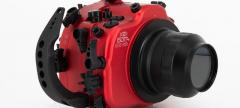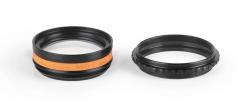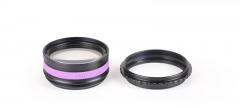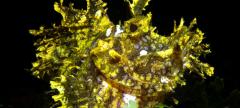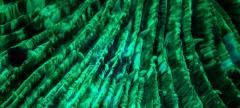The Bobbit Worm, Eunice Aphroditois
The Bobbit worm, Eunice aphroditois, is a ferocious underwater predator. The bobbit worm, also known as the Eunice worm, can be found in sandy, mucky dive sites in many places of the world.
Scuba diving sites where the bobbit worm has been seen includes Secret bay in Bali, Indonesia - Police Pier & Nudie Retreat in Lembeh, Indonesia - and Mainit Muck or Basura in Anilao, Phillipines. This worm likes sandy and gravel substrates, that you would find on "muck" dives.

The bobbit worm has light and chemical receptors that cause it to lunge at fish when it thinks they are nearby. It has 5 antennae that house these sensory receptors.
Update - June 2009 - many bobbit worms have been seen at Air Prang dive site, Lembeh, Indonesia.
Update - 2018 - bobbit worms are plentiful in Anilao, Philippines. Ask your guide where! (Hint - it's dark, shallow, and there is lots of sand.)
Bobbit Worm Myths and Facts
Bobbit worms are Polychaete worms in the phylum Annelida. I've also seen them called sand strikers, because of how quickly they appear to strike out of nowhere in the sand.
A common myth about the Bobbit Worm is that they got their name from the fact that the female worms cuts off the penis of the male worm after mating, and then feeds it to her young. This is actually not true.
Here's some facts from Polychaete expert Leslie Harris at the Natural History Museum in Los Angeles:
First off, Polychaetes don't have penises or vaginas. Most of them are what we call broadcast spawners which means the males & females spew out eggs & sperm into the water. The eggs & sperm meet, the eggs get fertilized & start developing. There is no such thing as mating/copulation not do males & females come into contact. Only a very few species exhibit parental care which is minimal. It consists of the female creating a mucus cocoon for the eggs & keeping it clean or brooding the eggs within her own tube. Some species of Marphysa (which are in the same family as the genus Eunice) produce egg cocoons. Females do not care for larvae or juveniles & they certainly do not feed them.
The association of "Bobbit" for Eunice aphroditois has 2 possible origins. The 1st - and the one I heard way back when - is that the outstretched jaws resemble scissors. The 2nd is that the erect worms reminded someone of an unattached penis.
Bobbit worms don't like bright lights. When searching for them underwater, we often wave our lights quickly and avoid shining a light directly on them for more than a second. A disturbed bobbit worm will often retract down into the sand for a long period of time.
Bobbit worm claws and jaws
What you call the "claws" are jaws. there are 2 types of jaw pieces - 1 pair of mandibles and 4-6 pairs of maxillae. The big serrated hooked pieces are maxillae. In the close up the 5 striped filaments are the antennae & palps - these carry the sensory receptors. They have 1 pair of eyes at the base of the antennae but they may not play a big role in food capture. Bobbit worms are ambush predators but if they're really hungry they will scavenge for food around the opening to their burrows.
Their mandibles are so strong, they can chop their prey right in half. I certainly would not want to give them my bare finger.
Thanks to Leslie Harris for this infomation.
According to Wikepedia, the longest Bobbit worm on record is 299cm. That is almos 10 feet long! I'm not sure how "stretched out" that is.The ones that I've seen underwater do not appear to be that large, but it is difficult to tell because most of their body is down in their burrow.
Bobbit Worm Underwater Photo tips:
Bobbit worms are nocturnal
Don't shine your light on the bobbit worm for too long
Use a good guide who has found them before
The bobbit worm will often react to a light being shined on it only once or twice, lunging into the air, until it learns there is nothing there
It doesn't seem to mind being closely approached, if you can get it to stay out
Don't touch it, and don't get grabbed, the claws are very powerful and can injure you
Be ready with your shots, because the worm can move very very fast.

Bobbit worm out of its hole

Bobbit worm grabbing a fish.. The fish disappeared less than a 1/2 second later, I got very very lucky with this shot.

Close-up showing the claws of the bobbit worm.

Bobbit worm lunging at a fish.
Diet - what do they eat?
When I've witnessed a bobbit worm feeding, it was usually on a cardinal fish or a puffer fish. Both are slow moving fish that often wander over the sand at night. The worm senses passing prey with its antennae, and strikes very quicky, then dragging the fish into the sand. It is quite a sight to see!
The Bobbit worm can even capture larger fish, and they often feed on pufferfish who slowly swim over them. Check out this photo -

Yes, this is a photo I took of a pufferfish being captured by a Bobbit worm. I swam over and pulled on the pufferfish. With a little bit of effort, I managed to release it. The pufferfish was still quite alive and quickly & happily swam away!
I've seen Bobbit worms capture cardinal fish and suck them under the sand within seconds. There's a video online of a bobbit worm decapitating several fish in a row, wow.
How big do they get?
Up to 9ft long! This one was 4ft long. That's a lot bigger than I had thought.
Bobbit worms in the movies
Ever see the movie Dune? The sand creatures are clearly modelled after Bobbit worms!
Further Reading
Featured Marine Life Articles
Nudibranchs - beautiful slugs of the ocean
Leafy Sea Dragon - expert at camouflage, beautiful fish
Frogfish - Camouflaged ambush predators
Black Sea Bass - Gentle giants of California
Wonderpus Octopus - Most beautiful Octopus in the ocean






